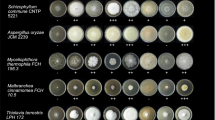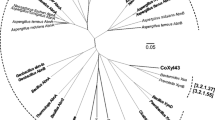Abstract
Pedobacter are a representative genus of soil-associated bacteria. Here we have provided the complete genome sequence of Pedobacter sp. PAMC26386 isolated from Antarctic soil, and functionally annotated the genome, describing the unique features of carbohydrate active enzymes (CAZymes) and α-L-arabinofuranosidase (α-L-ABF). The genome of Pedobacter sp. PAMC26386 is circular and comprises 4,796,773 bp, with a 38.2% GC content. The genome encodes 4,175 genes, including 7 rRNA and 44 tRNA genes. We identified 172 genes (8 auxiliary activities, 8 carbohydrate binding modules, 23 carbohydrate esterases, 86 glycoside hydrolases, 42 glycosyl transferases, and 5 polysaccharide lyases) related to CAZymes using the dbCAN2 tool. We checked enzyme activity on 11 substrates using the AZCL assay and obtained strong activity for arabinooligosaccharide and hemicellulose. This includes information regarding α-L-ABF, which is active at low temperatures, based on the annotation results. Our findings on Pedobacter sp. PAMC26386 provide the basis for research in the future. The favorable properties of Pedobacter sp. PAMC26386 make it a good candidate for industrial applications involving low temperatures.





Similar content being viewed by others
References
Steyn PL, Segers P, Vancanneyt M, Sandra P, Kersters K, Joubert JJ (1998) Classification of heparinolytic bacteria into a new genus, Pedobacter, comprising four species: Pedobacter heparinus comb. nov., Pedobacter piscium comb. nov., Pedobacter africanus sp. nov. and Pedobacter saltans sp. nov. proposal of the family Sphingobacteriaceae fam. nov. Int J Syst Bacteriol 48(1):165–177. https://doi.org/10.1099/00207713-48-1-165
Wei Y, Wang B, Zhang L, Zhang J, Chen S (2018) Pedobacter yulinensis sp. nov., isolated from sandy soil, and emended description of the genus Pedobacter. Int J Syst Evol Microbiol 68(8):2523–2529. https://doi.org/10.1099/ijsem.0.002868
Zhang B, Liu ZQ, Zheng YG (2018) Pedobacter quisquiliarum sp. nov., isolated from activated sludge. Int J Syst Evol Microbiol 68(1):438–442. https://doi.org/10.1099/ijsem.0.002531
Hwang CY, Choi DH, Cho BC (2006) Pedobacter roseus sp. nov., isolated from a hypertrophic pond, and emended description of the genus Pedobacter. Int J Syst Evol Microbiol 56(8):1831–1836. https://doi.org/10.1099/ijs.0.64045-0
Joung Y, Jang HJ, Park M, Song J, Cho JC (2018) Pedobacter aquicola sp. nov., isolated from freshwater. J Microbiol 56(7):478–484. https://doi.org/10.1007/s12275-018-7499-3
Gao JL, Sun P, Mao XJ, Du YL, Liu BY, Sun JG (2017) Pedobacter zeae sp. nov., an endophytic bacterium isolated from maize root. Int J Syst Evol Microbiol 67(2):231–236. https://doi.org/10.1099/ijsem.0.001603
Covas C, Caetano T, Cruz A, Santos T, Dias L, Klein G, Abdulmawjood A, Rodríguez-Alcalá LM, Pimentel LL, Gomes A, Freitas AC, Garcia-Serrano A, Fontecha J, Mendo S (2017) Pedobacter lusitanus sp. nov., isolated from sludge of a deactivated uranium mine. Int J Syst Evol Microbiol 67(5):1339–1348. https://doi.org/10.1099/ijsem.0.001814
Švec P, Králová S, Busse HJ, Kleinhagauer T, Pantůček R, Mašlaňová I, Cnockaert M, Vandamme P, Staňková E, Gelbíčová T, Holochová P, Barták M, Kýrová K, Sedláček I (2017) Pedobacter jamesrossensis sp. nov., Pedobacter lithocola sp. nov., Pedobacter mendelii sp. nov. and Pedobacter petrophilus sp. nov., isolated from the Antarctic environment. Int J Syst Evol Microbiol 67(5):1499–1507. https://doi.org/10.1099/ijsem.0.001749
Margesin R, Sproer C, Schumann P, Schinner F (2003) Pedobacter cryoconitis sp. nov., a facultative psychrophile from alpine glacier cryoconite. Int J Syst Evol Microbiol 53(5):1291–1296. https://doi.org/10.1099/ijs.0.02436-0
He XY, Li N, Chen XL, Zhang YZ, Zhang XY, Song XY (2020) Pedobacter indicus sp. nov., isolated from deep-sea sediment. Antonie Van Leeuwenhoek 113(3):357–364. https://doi.org/10.1007/s10482-019-01346-9
Kangale LJ, Raoult D, Ghigo E, Fournier PE (2020) Pedobacter schmidteae sp. nov., a new bacterium isolated from the microbiota of the planarian Schmidtea mediterranea. Sci Rep. https://doi.org/10.1038/s41598-020-62985-x
Sheehan J, Aden A, Paustian K, Killian K, Brenner J, Walsh M, Nelson R (2008) Energy and environmental aspects of using corn stover for fuel ethanol. J Ind Ecol 7(3–4):117–146. https://doi.org/10.1162/108819803323059433
Wang L, Sharifzadeh M, Templer R, Murphy RJ (2013) Bioethanol production from various waste papers: Economic feasibility and sensitivity analysis. Appl Energy 111:1172–1182. https://doi.org/10.1016/j.apenergy.2012.08.048
Geng A, Wu J, Xie R, Wang H, Wu Y, Li X, Chang F, Sun J (2019) Highly thermostable GH51 α-arabinofuranosidase from Hungateiclostridium clariflavum DSM 19732. Appl Microbiol Biotechnol 103(9):3783–3793. https://doi.org/10.1007/s00253-019-09753-8
McGregor NGS, Artola M, Nin-Hill A, Linzel D, Haon M, Reijngoud J, Ram A, Rosso MN, van der Marel GA, Codée JDC, van Wezel GP, Berrin JG, Rovira C, Overkleeft HS, Davies GJ (2020) Rational design of mechanism-based inhibitors and activity-based probes for the identification of retaining α-l-arabinofuranosidases. J Am Chem Soc 142(10):4648–4662. https://doi.org/10.1021/jacs.9b11351
Paës G, O’Donohue MJ (2006) Engineering increased thermostability in the thermostable GH-11 xylanase from Thermobacillus xylanilyticus. J Biotechnol 125(3):338–350. https://doi.org/10.1016/j.jbiotec.2006.03.025
Dos Santos CR, de Giuseppe PO, de Souza FHM, Zanphorlin LM, Domingues MN, Pirolla RAS, Honorato RV, Tonoli CCC, de Morais MAB, de Matos Martins VP, Fonseca LM, Büchli F, de Oliveira PSL, Gozzo FC, Murakami MT (2018) The mechanism by which a distinguishing arabinofuranosidase can cope with internal di-substitutions in arabinoxylans. Biotechnol Biofuels 11:223. https://doi.org/10.1186/s13068-018-1212-y
Höcker B, Jürgens C, Wilmanns M, Sterner R (2001) Stability, catalytic versatility and evolution of the (beta alpha) (8)-barrel fold. Curr Opin Biotechnol 12(4):376–381. https://doi.org/10.1016/s0958-1669(00)00230-5
Lagaert S, Pollet A, Courtin CM, Volckaert G (2014) β-xylosidases and α-L-arabinofuranosidases: accessory enzymes for arabinoxylan degradation. Biotechnol Adv 32(2):316–332. https://doi.org/10.1016/j.biotechadv.2013.11.005
Edgar RC (2004) MUSCLE: multiple sequence alignment with high accuracy and high throughput. Nucleic Acids Res 32(5):1792–1797. https://doi.org/10.1093/nar/gkh340
Kumar S, Stecher G, Li M, Knyaz C, Tamura K (2018) MEGA X: molecular evolutionary genetics analysis across computing platforms. Mol Biol Evol 35(6):1547–1549. https://doi.org/10.1093/molbev/msy096
Chin CS, Alexander DH, Marks P, Klammer AA, Drake J, Heiner C, Clum A, Copeland A, Huddleston J, Eichler EE, Turner SW, Korlach J (2013) Nonhybrid, finished microbial genome assemblies from long-read SMRT sequencing data. Nat Methods 10(6):563–569. https://doi.org/10.1038/nmeth.2474
Aziz RK, Bartels D, Best AA, DeJongh M, Disz T, Edwards RA, Formsma K, Gerdes S, Glass EM, Kubal M, Meyer F, Olsen GJ, Olson R, Osterman AL, Overbeek RA, McNeil LK, Paarmann D, Paczian T, Parrello B, Pusch GD, Reich C, Stevens R, Vassieva O, Vonstein V, Wilke A, Zagnitko O (2008) The RAST Server: rapid annotations using subsystems technology. BMC Genomics 9:75. https://doi.org/10.1186/1471-2164-9-75
Huerta-Cepas J, Szklarczyk D, Heller D, Hernández-Plaza A, Forslund SK, Cook H, Mende DR, Letunic I, Rattei T, Jensen LJ, von Mering C, Bork P (2019) eggNOG 5.0: a hierarchical, functionally and phylogenetically annotated orthology resource based on 5090 organisms and 2502 viruses. Nucleic Acids Res. https://doi.org/10.1093/nar/gky1085
Zhang H, Yohe T, Huang L, Entwistle S, Wu P, Yang Z, Busk PK, Xu Y, Yin Y (2018) dbCAN2: a meta server for automated carbohydrate-active enzyme annotation. Nucleic Acids Res 46(W1):W95–W101. https://doi.org/10.1093/nar/gky418
Lombard V, Golaconda Ramulu H, Drula E, Coutinho PM, Henrissat B (2014) The carbohydrate-active enzymes database (CAZy) in 2013. Nucleic Acids Res 42:D490–D495. https://doi.org/10.1093/nar/gkt1178
Wang S, Yang B, Ross RP, Stanton C, Zhao J, Zhang H, Chen W (2020) Comparative genomics analysis of Lactobacillus ruminis from different niches. Genes 11(1):70. https://doi.org/10.3390/genes11010070
Lee I, Kim YO, Park SC, Chun J (2016) OrthoANI: an improved algorithm and software for calculating average nucleotide identity. Int J Syst Evol Microbiol 66(2):1100–1103. https://doi.org/10.1099/ijsem.0.000760
Kračun SK, Schückel J, Westereng B, Thygesen LG, Monrad RN, Eijsink VGH, Willats WGT (2015) A new generation of versatile chromogenic substrates for high-throughput analysis of biomass-degrading enzymes. Biotechnol Biofuels 8:70. https://doi.org/10.1186/s13068-015-0250-y
Goris J, Konstantinidis KT, Klappenbach JA, Coenye T, Vandamme P, Tiedje JM (2007) DNA–DNA hybridization values and their relationship to whole-genome sequence similarities. Int J Syst Evol Microbiol 57(1):81–91. https://doi.org/10.1099/ijs.0.64483-0
Grant JR, Arantes AS, Stothard P (2012) Comparing thousands of circular genomes using the CGView Comparison Tool. BMC Genomics 13:202. https://doi.org/10.1186/1471-2164-13-202
Han SR, Jang SM, Chi YM, Kim B, Jung SH, Lee YM, Uetake J, Lee JH, Park H, Oh TJ (2020) Complete genome sequence of Sphingobium sp. strain PAMC 28499 reveals a potential for degrading pectin with comparative genomics approach. Genes Genomics 42(9):1087–1096. https://doi.org/10.1007/s13258-020-00976-y
Shi H, Zhang Y, Xu B, Tu M, Wang F (2014) Characterization of a novel GH2 family α-L-arabinofuranosidase from hyperthermophilic bacterium Thermotoga thermarum. Biotechnol Lett 36(6):1321–1328. https://doi.org/10.1007/s10529-014-1493-6
Poria V, Saini JK, Singh S, Nain L, Kuhad RC (2020) Arabinofuranosidases: Characteristics, microbial production, and potential in waste valorization and industrial applications. Bioresour Technol 304:123019. https://doi.org/10.1016/j.biortech.2020.123019
Eckert K, Schneider E (2003) A thermoacidophilic endoglucanase (CelB) from Alicyclobacillus acidocaldarius displays high sequence similarity to arabinofuranosidases belonging to family 51 of glycoside hydrolases. Eur J Biochem 270(17):3593–3602. https://doi.org/10.1046/j.1432-1033.2003.03744.x
Tu T, Li X, Meng K, Bai Y, Wang Y, Wang Z, Yao B, Luo H (2019) A GH51 α-L-arabinofuranosidase from Talaromyces leycettanus strain JCM12802 that selectively drives synergistic lignocellulose hydrolysis. Microb Cell Fact 18(1):138. https://doi.org/10.1186/s12934-019-1192-z
Debeche T, Bliard C, Debeire P, O’Donohue MJ (2002) Probing the catalytically essential residues of the α-L-arabinofuranosidase from Thermobacillus xylanilyticus. Protein Eng 15(1):21–28. https://doi.org/10.1093/protein/15.1.21
Miyazaki K (2005) Hyperthermophilic α-L-arabinofuranosidase from Thermotoga maritima MSB8: molecular cloning, gene expression, and characterization of the recombinant protein. Extremophiles 9(5):399–406. https://doi.org/10.1007/s00792-005-0455-2
Dumbrepatil A, Park JM, Jung TY, Song HN, Jang MU, Han NS, Kim TJ, Woo EJ (2012) Structural analysis of α-L-arabinofuranosidase from Thermotoga maritima reveals characteristics for thermostability and substrate specificity. J Microbiol Biotechnol 22(12):1724–1730. https://doi.org/10.4014/jmb.1208.08043
Hoffmam ZB, Oliveira LC, Cota J, Alvarez TM, Diogo JA, de Oliveira NM, Citadini APS, Leite VBP, Squina FM, Murakami MT, Ruller R (2013) Characterization of a hexameric exo-acting GH51 α-L-arabinofuranosidase from the mesophilic Bacillus subtilis. Mol Biotechnol 55(3):260–267. https://doi.org/10.1007/s12033-013-9677-1
Sürmeli Y, İlgü H, Şanlı-Mohamed G (2019) Improved activity of α-L-arabinofuranosidase from Geobacillus vulcani GS90 by directed evolution: Investigation on thermal and alkaline stability. Biotechnol Appl Biochem 66(1):101–107. https://doi.org/10.1002/bab.1702
Shi P, Li N, Yang P, Wang Y, Luo H, Bai Y, Yao B (2010) Gene cloning, expression, and characterization of a Family 51 α-L-arabinofuranosidase from Streptomyces sp. S9. Appl Biochem Biotechnol 162(3):707–718. https://doi.org/10.1007/s12010-009-8816-4
Canakci S, Kacagan M, Inan K, Belduz AO, Saha BC (2008) Cloning, purification, and characterization of a thermostable α-L-arabinofuranosidase from Anoxybacillus kestanbolensis AC26Sari. Appl Microbiol Biotechnol 81(1):61–68. https://doi.org/10.1007/s00253-008-1584-1
Acknowledgement
This research was a part of the project titled “Development of potential antibiotic compounds using polar organism resources (15250103, KOPRI Grant PM20030)”, funded by the Ministry of Oceans and Fisheries, Korea.
Author information
Authors and Affiliations
Contributions
T.-J.O. designed and supervised the project. C.-Y.C. and S.-R.H. performed the genome analysis. All authors discussed the results, commented on the manuscript, and approved the manuscript.
Corresponding author
Ethics declarations
Conflict of interest
The authors have no conflicts of interest to declare.
Additional information
Publisher's Note
Springer Nature remains neutral with regard to jurisdictional claims in published maps and institutional affiliations.
Supplementary Information
Below is the link to the electronic supplementary material.
Rights and permissions
About this article
Cite this article
Cho, CY., Han, SR. & Oh, TJ. Complete Genome Sequence of Pedobacter sp. PAMC26386 and Their Low Temperature Application in Arabinose-containing Polysaccharides Degradation. Curr Microbiol 78, 944–953 (2021). https://doi.org/10.1007/s00284-021-02364-5
Received:
Accepted:
Published:
Issue Date:
DOI: https://doi.org/10.1007/s00284-021-02364-5




